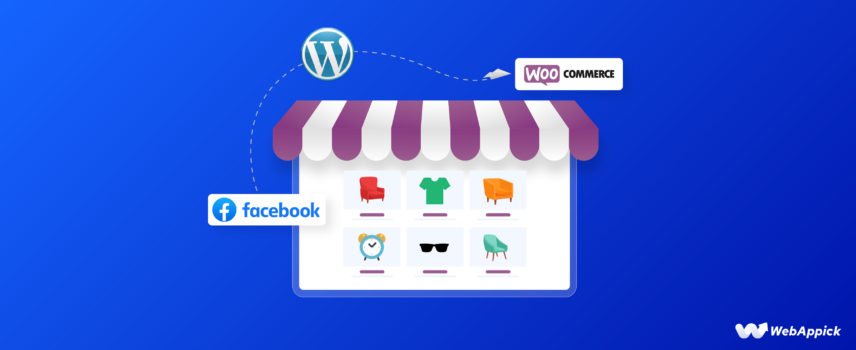
How to Integrate the Facebook Marketplace with WooCommerce Store
To integrate Facebook Marketplace with your WooCommerce store, you’ll connect your WooCommerce product feed to Meta Commerce Manager—Facebook’s platform for managing catalogs, attributes, and product distribution across Facebook Shop, Marketplace, and Instagram Shopping.
By using a feed URL generated from a tool like CTX Feed – WooCommerce Product Feed Plugin , Commerce Manager can continuously sync key product attributes such as ID, title, price, availability, image_link, brand, GTIN/MPN, and google_product_category/fb_product_category.
This creates a real-time, structured product catalog that keeps your WooCommerce data aligned with Meta’s eCommerce while ensuring seamless visibility across Facebook and Instagram.
This article will guide you through the process of WooCommerce Facebook integration, providing a step-by-step walkthrough. You will learn to create and upload a product feed to Facebook for seamless integration.
Let’s begin.
What is Facebook Marketplace?
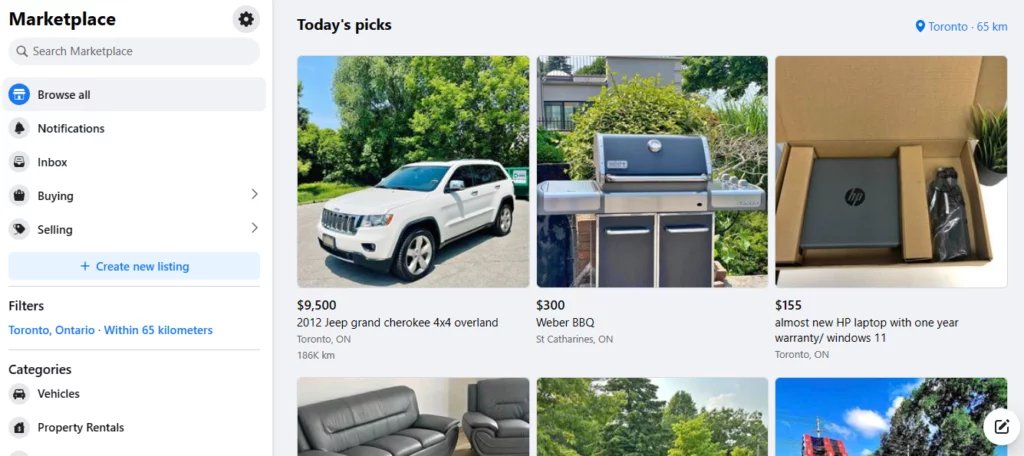
Facebook Marketplace is an online hub built within Facebook that allows users to buy and sell various items locally. It’s like a virtual garage sale or flea market, where you can find everything from furniture and clothing to electronics and vehicles.
Initially designed solely as a peer-to-peer shopping platform, Facebook Marketplace now includes merchant selling. This means WooCommerce retailers like you can upload and list your online store products in bulk.
We will guide you through the process of WooCommerce Facebook integration later in the article. However, we must mention that the merchant selling feature is only available in limited countries.
Here’s a breakdown of what Facebook Marketplace is all about:
For buyers:
- Browse and search for items: You can browse through listings by category, location, or price range. You can also search for specific items using keywords.
- Connect with sellers: Once you find an item you’re interested in, you can message the seller directly to ask questions or negotiate a price.
- Arrange meetups: Buyers and sellers typically arrange to meet in person to complete the transaction. Sellers can also offer cash on delivery through Currier. Facebook Marketplace does not facilitate payments, so it’s up to you to agree on a payment method that works for both of you.
For sellers:
- Create listings: You can easily create listings for items you want to sell, including photos, descriptions, and a price.
- Reach a wide audience: Your listings will be seen by people in your local area, as well as by people who are searching for items like yours.
- Communicate with buyers: You can answer questions from potential buyers and negotiate prices through Messenger.
Facebook Marketplace is an enormously popular platform for reaching your target customers and growing your online/offline sales.
How to list single items and sell them on the Marketplace
Before we learn how to integrate Facebook with WooCommerce, let’s find out how the platform works for single-item sellers and buyers.
Listing items individually on the Marketplace is pretty straightforward. You can access Marketplace from both the desktop and mobile apps.
Here’s what the Marketplace looks like.
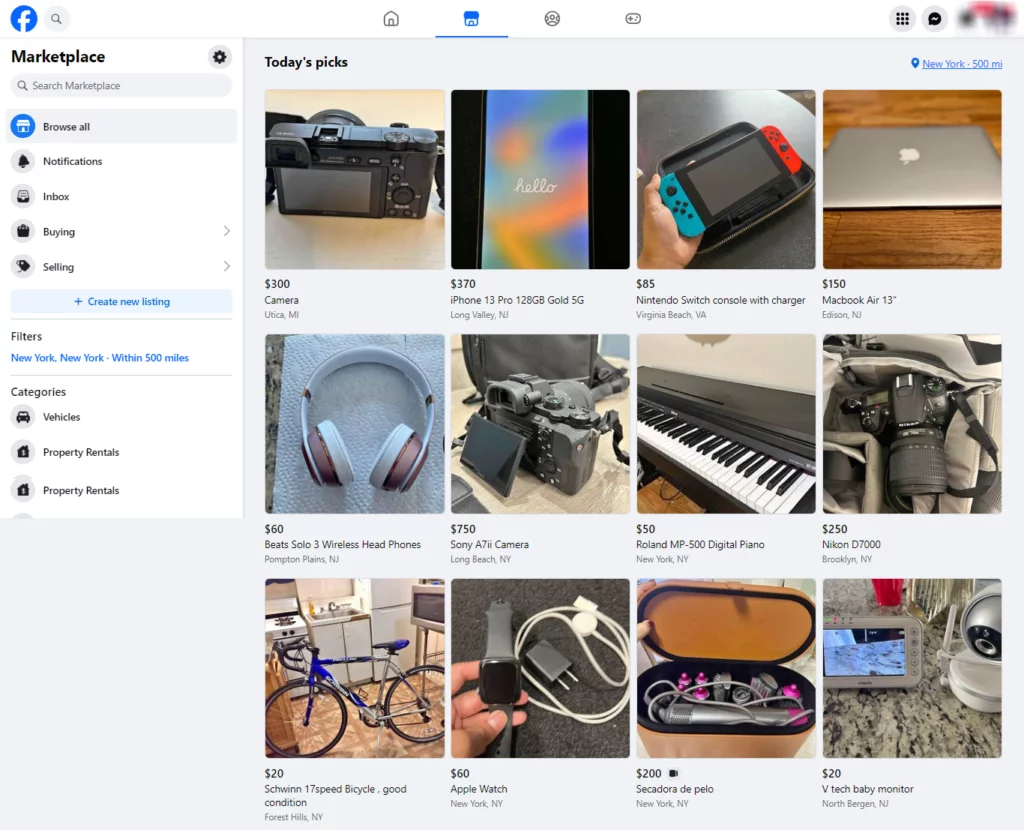
Whether you are a seller or buyer, the first thing you will need to do is set your location. As a buyer or seller, you can set a maximum radius of up to 500 miles.
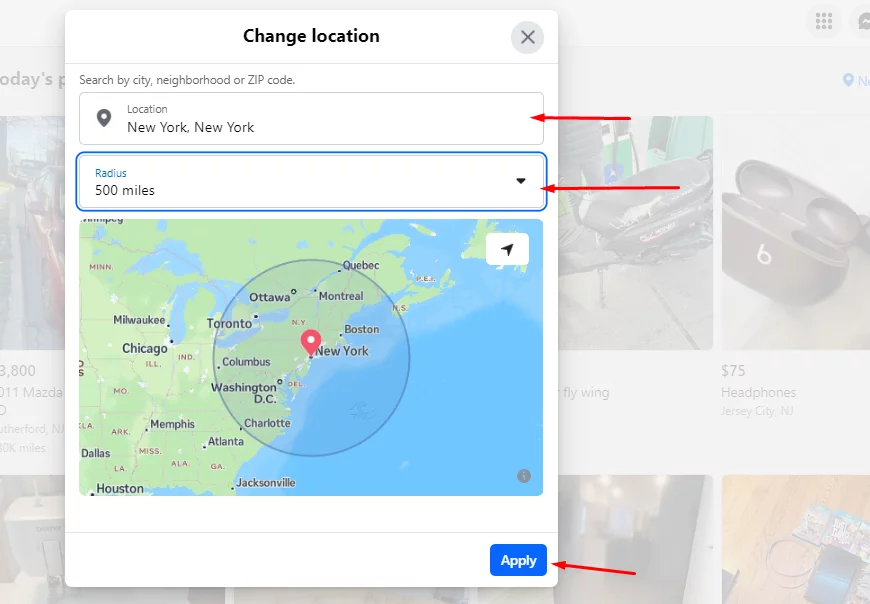
A buyer can specifically search for the product they are looking for or filter their search by categories.

Let’s check out how to create a single listing in the Marketplace. Click on the Create New Listing button.
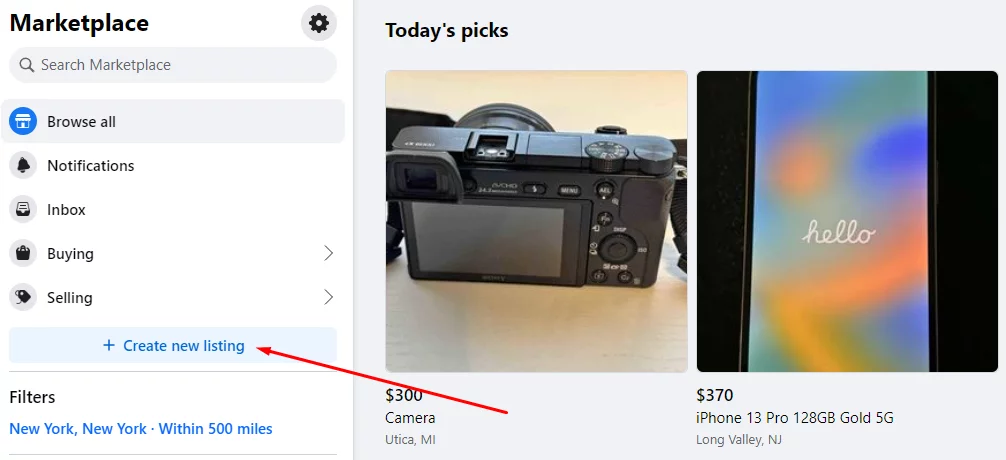
We will go with the Item for sale option.
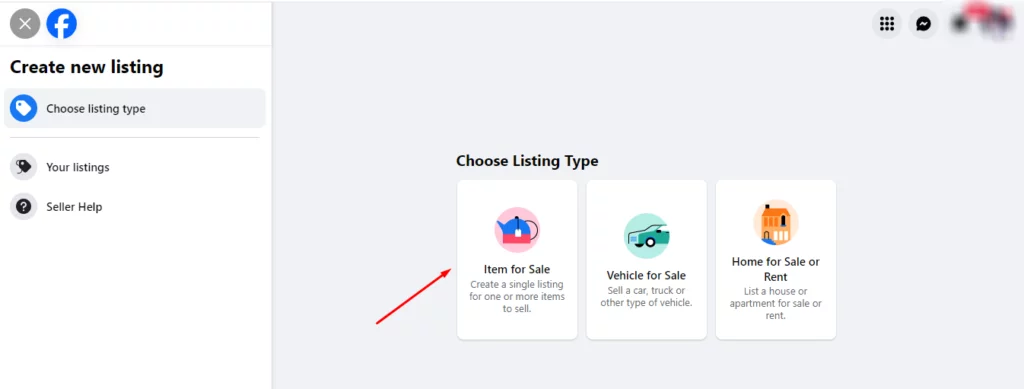
You can start by adding your product photos and videos.
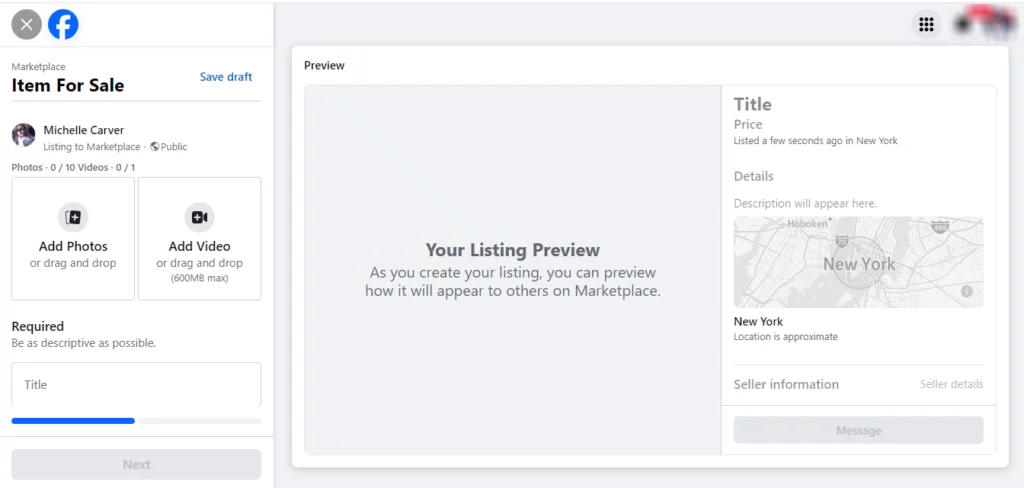
Next, enter your product’s basics and choose a category.
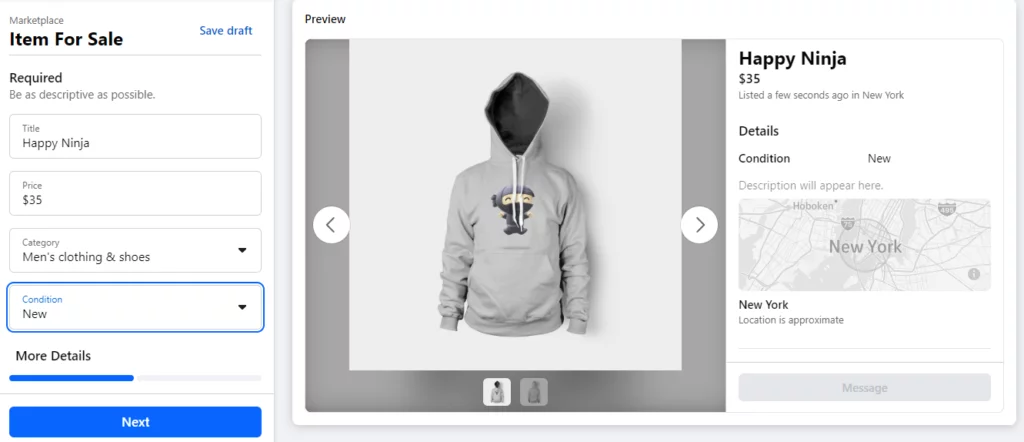
Scroll down, click on More Details, and input your product details.
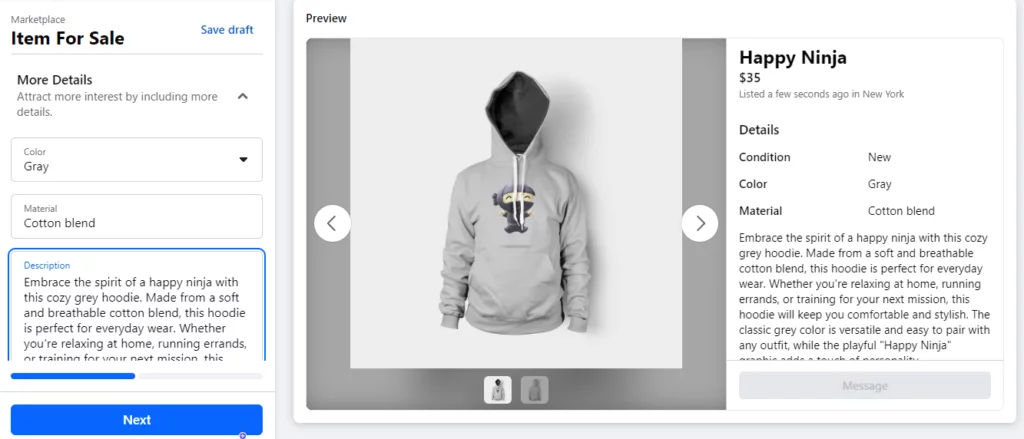
Set the product in stock if you are selling more than one piece of that product. Otherwise, set the List as Single Item option. Also, set your location.
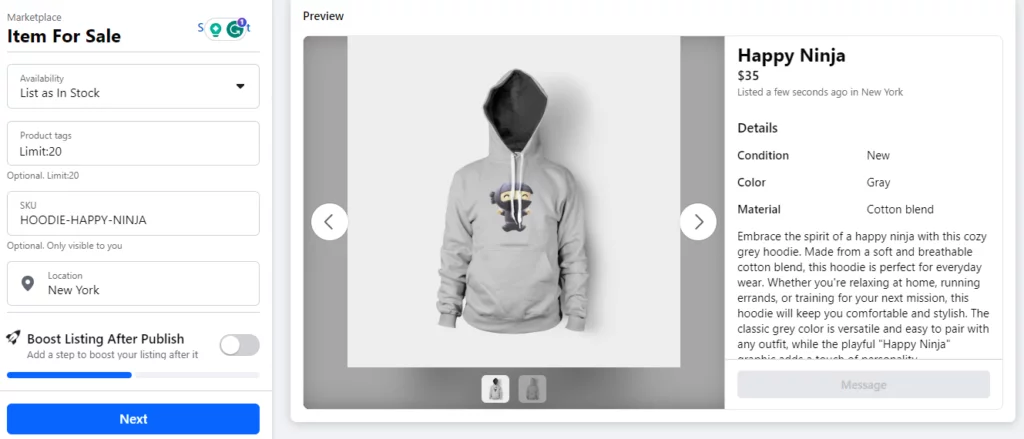
After that, Facebook will offer you the option to publish the item in your groups or boost the listing right after you publish it.
These are optional; you can publish your listing by skipping these options.
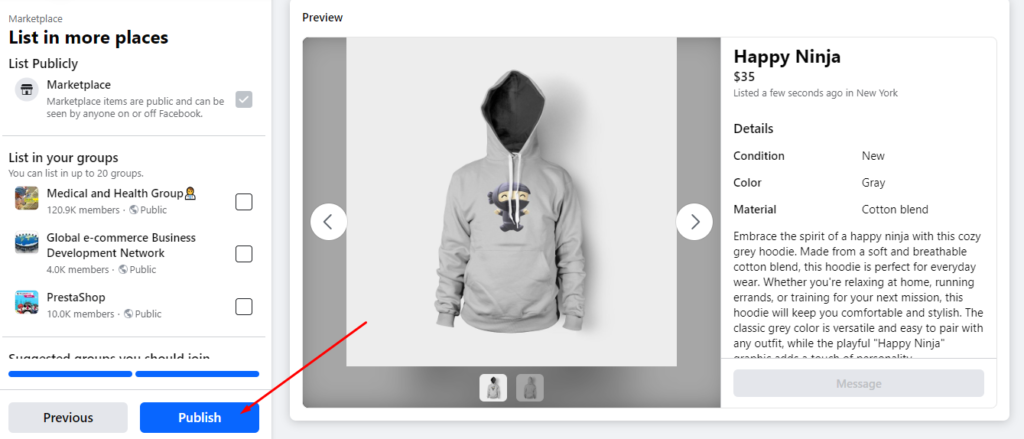
Right after you hit the publish button, Facebook will list your product on Marketplace, and it will be visible to the customers in your set area.
However, this individual product listing isn’t convenient for an eCommerce/WooCommerce retailer like you, is it?
It will take an incredible amount of time for you to list all your products one by one, and it will be a nightmare to update them on time when needed. That’s where you need WooCommerce Facebook integration.
WooCommerce Facebook integration – WooCommerce Facebook Catalog integration
Facebook offers a number of tools and platforms for eCommerce businesses to promote their products on the platform. And the good news is that Facebook made it really easy to integrate WooCommerce with Facebook or any other eCommerce platform.
Facebook has a dedicated platform called Meta Commerce Manager for integrating WooCommerce and Facebook. You can upload your products in bulk through a product feed and display them effortlessly across Facebook platforms.
Let us walk you step by step on how to integrate WooCommerce with Facebook Shop
The most important element you will need in this WooCommerce and Facebook integration process is a product feed.
What is a WooCommerce Facebook integration product feed?
In the most straightforward words, a product feed is most commonly a Google Sheet or Microsoft Excel sheet file that contains the list of your products and all their features and other details. It includes product information such as titles of your products, descriptions, categories, prices, shipping and tax information, etc.
You can include all your product details in a single product feed file and upload it to a feed-supporting platform like Facebook and Instagram. As a result, you can list and display all your products on the platform in one go.
Here’s an example of a regular Facebook product feed.
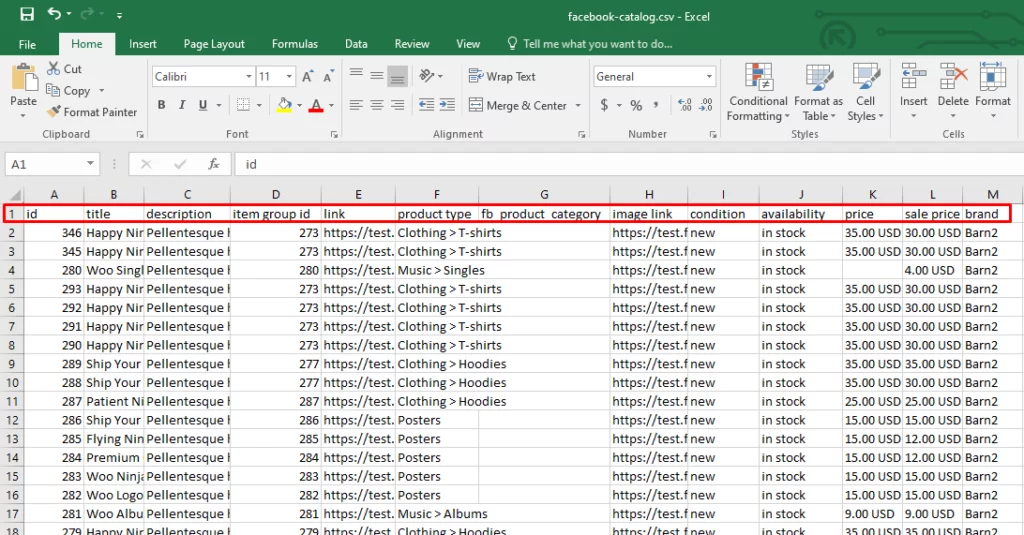
The red-marked (column headers) items are the characteristics of your products. These are known as attributes of product feeds.
Any channel that supports product feed marketing has its own list of attributes and guidelines everyone must follow. Here are Facebook’s attributes.
Attribute list for Facebook Marketplace
- Product ID
- Product title
- description
- availability
- inventory
- condition
- price
- link
- image_link
- Brand, MPN, or GTIN (include at least one)
- google_product_category / facebook_product_category
List of attributes for Facebook Shop
- id
- title
- description
- availability
- condition
- price
- link
- image_link
- Brand, MPN, or GTIN (include at least one)
Attributes for page shop, dynamic ads, Instagram shop
- id
- title
- description
- availability
- condition
- price
- link
- image_link
- Brand, MPN, or GTIN (include at least one)
How to create a WooCommerce Facebook Catalog feed
You can create a WooCommerce Facebook integration product feed in CSV, TXT, or XML formats and use code editor or spreadsheet tools like Google Sheets.
However, in this process, you will have to manually set the attributes and input your product information individually.
Therefore, this process is no different than the single listing process and will take a huge amount of time. This manual method is also prone to errors and can potentially lead to the rejection of the feed by Facebook.
You need an automated solution to save you from all the hassles and labor. WooCommerce plugin marketplace does offer a WooCommerce Facebook marketplace plugin, but the review says it’s not good enough.
The best WooCommerce Facebook integration plugin we found in the market is CTX Feed. It comes with a built-in template for Facebook that knows all guidelines and attributes.
You can effortlessly create a Facebook & Instagram product feed within seconds. The plugin automatically generates attributes, copies and pastes all your product details, and consistently updates them, streamlining your process.
CTX Feed also supports all possible file formats and URL feed connection methods where you no longer need to download and upload the file; simply connect the feed through its URL.
The plugin also supports Facebook pixel WooCommerce integration.
Overall, CTX Feed- WooCommerce Product Feed is a one-stop solution for creating and managing product feed files for over 130 channels.
How to create a Facebook Catalog feed?
Install the CTX Feed Free Plugin and activate it.
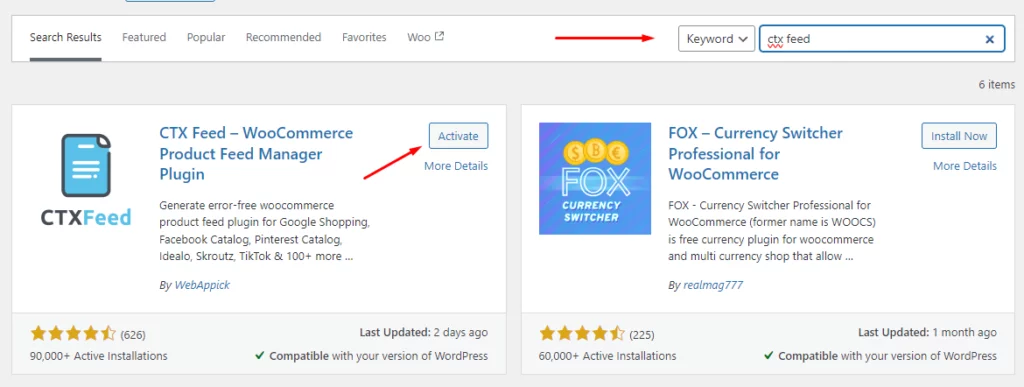
To start creating a feed, click on the following menu.
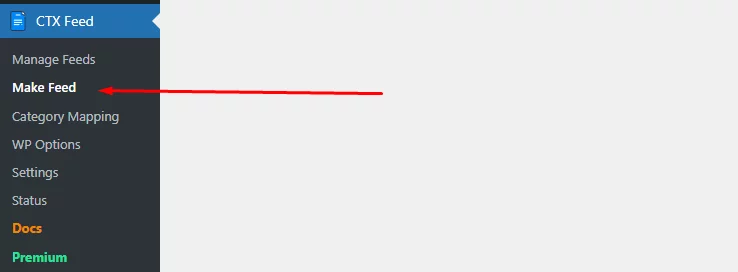
Select your preferred file type and select the Facebook template.
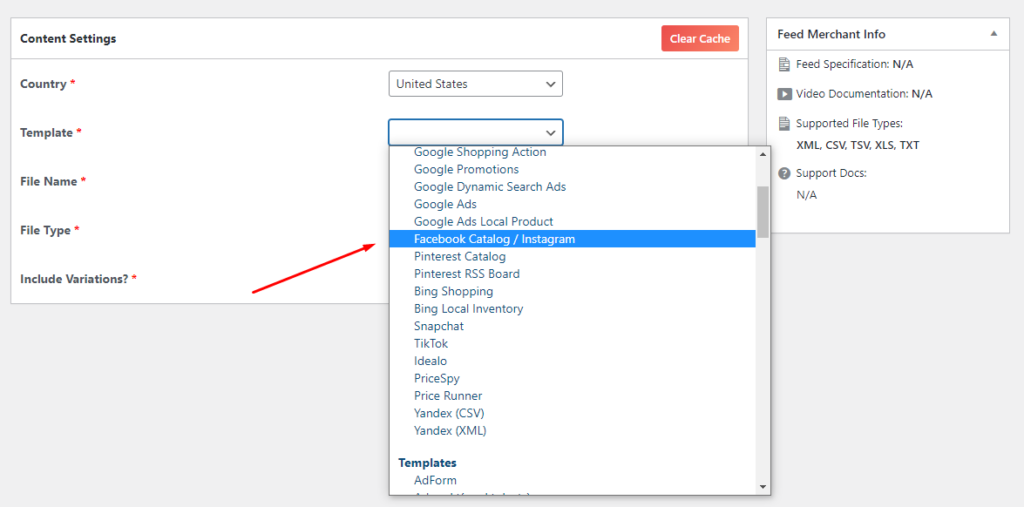
As we have said earlier, the plugin will do the rest automatically.
It will populate the necessary attributes at the bottom, and when you click generate, it will collect your product information and generate the feed.
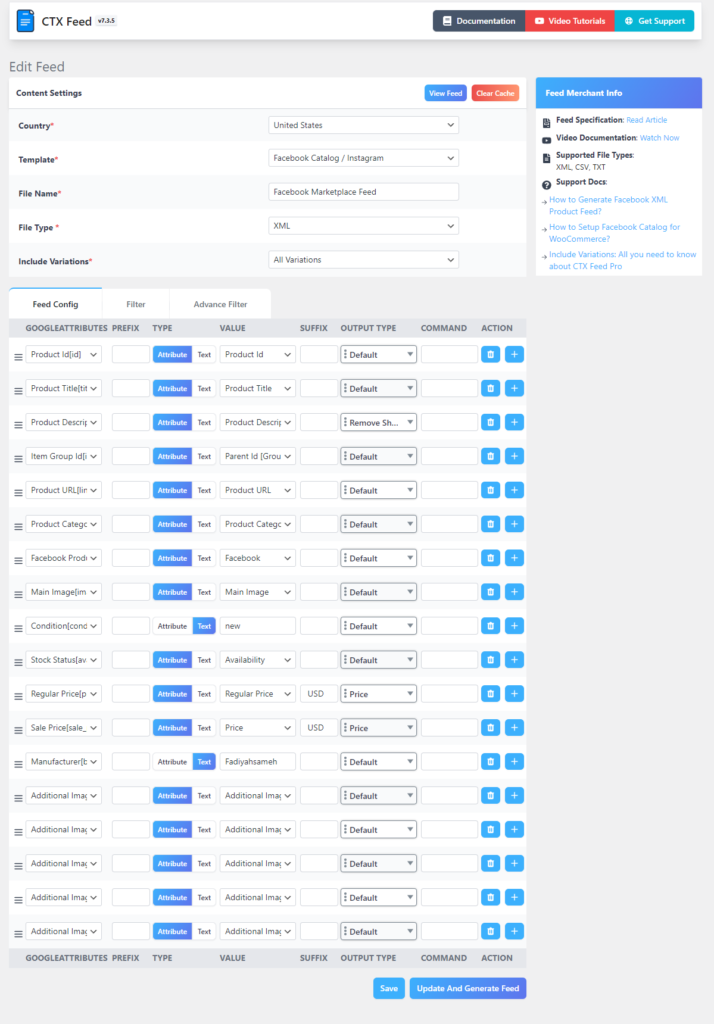
Additionally, you can add/edit attributes as per your need. You can also apply different filters and set tracking URLs for Facebook Pixel to track your campaign growth.
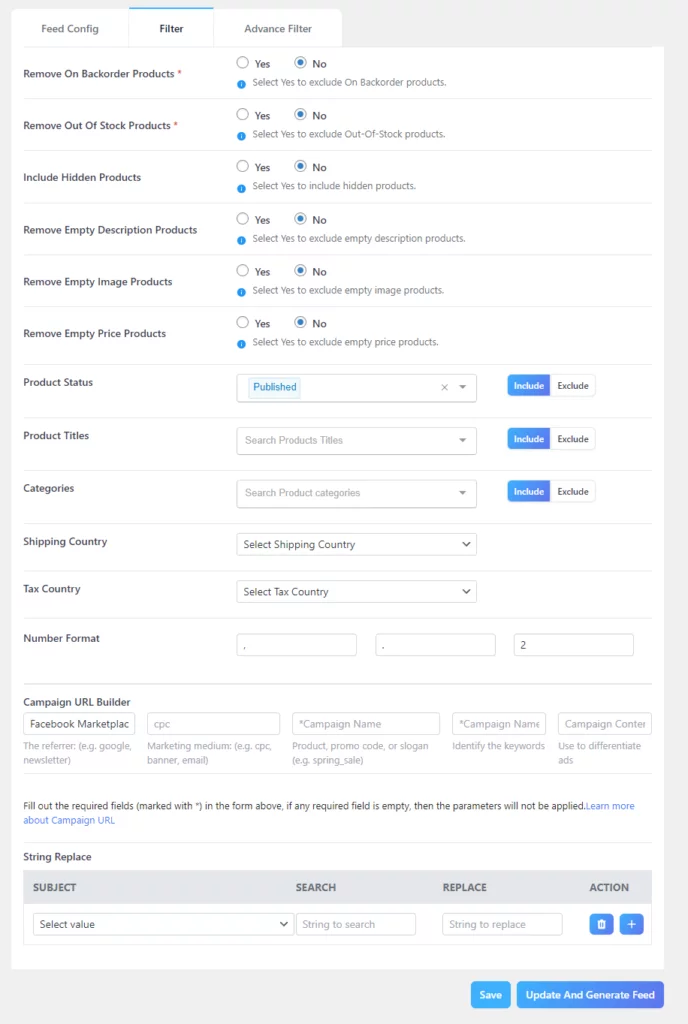
Adding custom fields and mapping categories
Now, there are some other tasks we need to point out. If you look at the list of Facebook required attributes, you will notice that it asks for fields like MPN, Brand, Facebook categories, GTIN, etc.
Let’s talk about GTIN, Brand, and MPN.
These fields are not available on WooCommerce product pages. Therefore, CTX Feed can’t enter value for them in your feed.
You must add these as custom fields in your product pages and then add their value. Adding custom fields on WordPress requires some technical knowledge, and that’s something not all store owners are fond of.
However, CTX Feed comes to your rescue by simplifying this process as well. The plugin has included all possible custom fields in its settings.
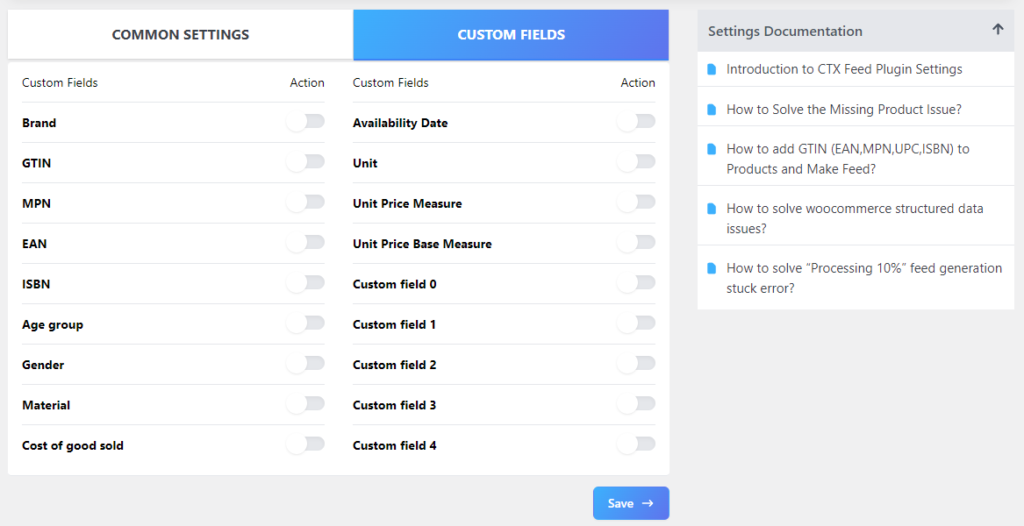
All you have to do is toggle to enable them.
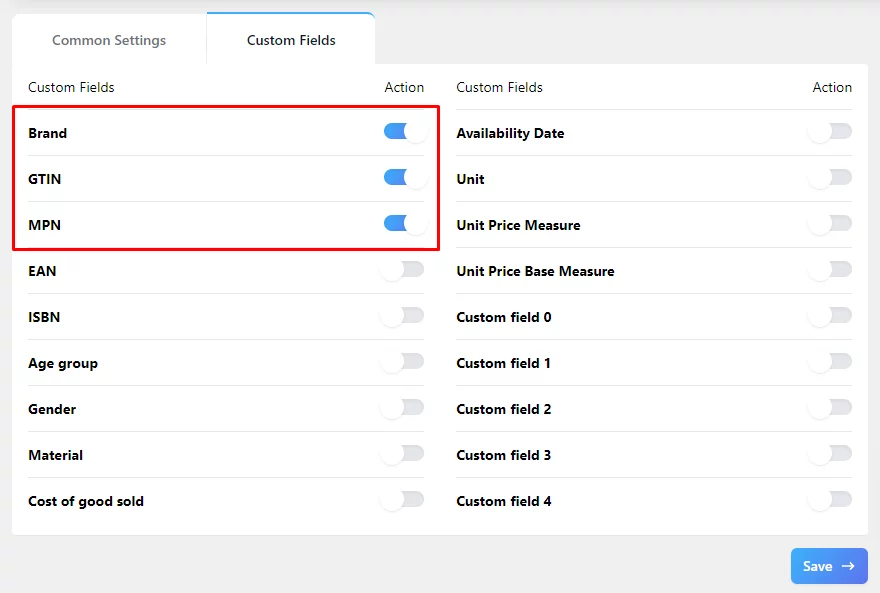
After that, go to your product pages, click on the Inventory tab, and enter values for the attributes. CTX Feed will automatically fetch these values when creating the feed.
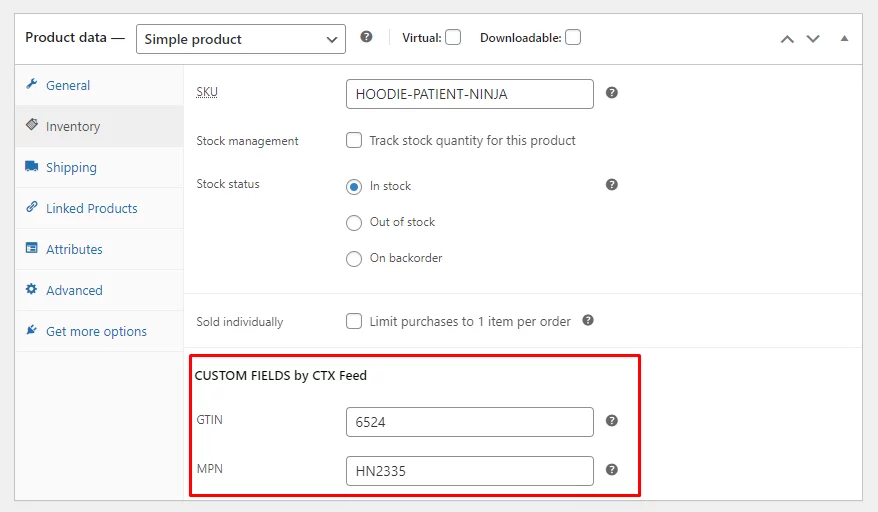
To create and assign brands, go to the following menu and create them.
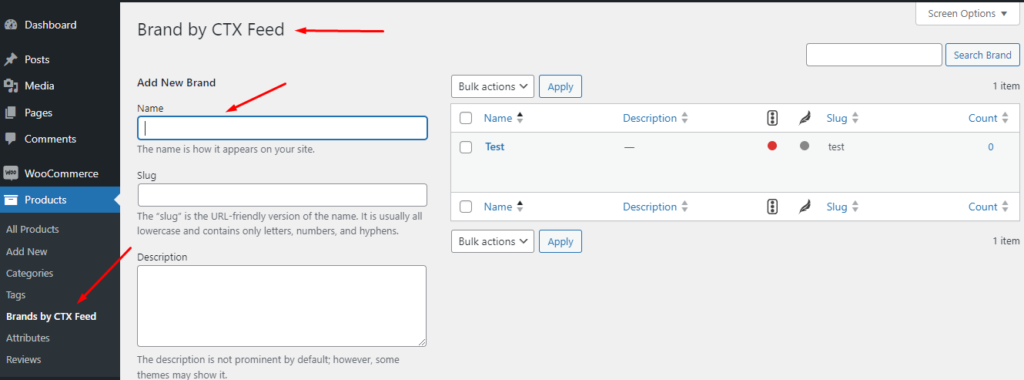
Assign from your individual product pages.
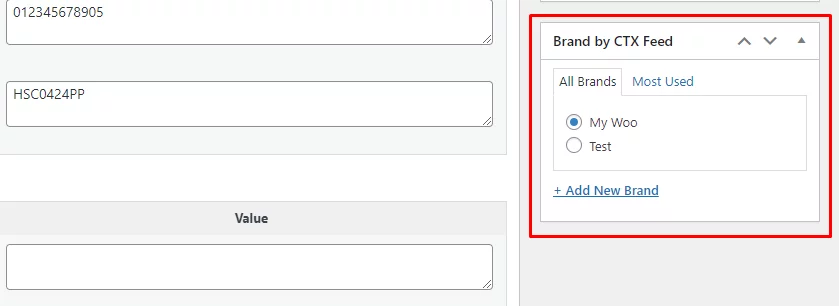
Facebook supports both Facebook and Google category mapping.
In a product feed, category mapping refers to the process of matching your store’s categories with the required or recommended categories of a specific platform (e.g., marketplace, shopping engine, ad network).
This is another reason why we picked CTX Feed. It makes category mapping a breeze.
Go to the following menu and create a new mapping attribute.
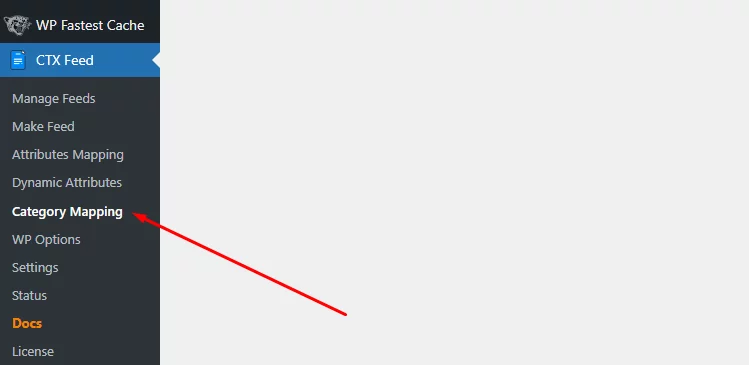
Select your merchant and map your WooCommerce website categories with Facebook/Google categories.
It can look something like this –
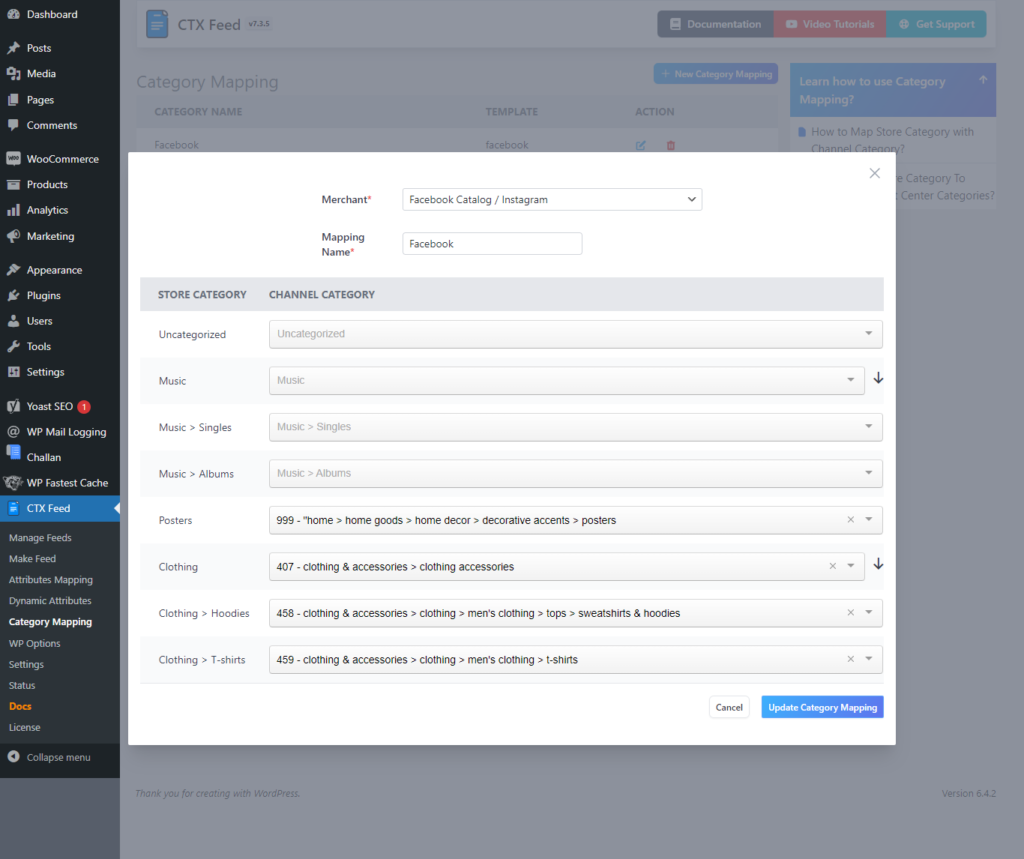
After you are done, assign this new attribute to your feed generation window.
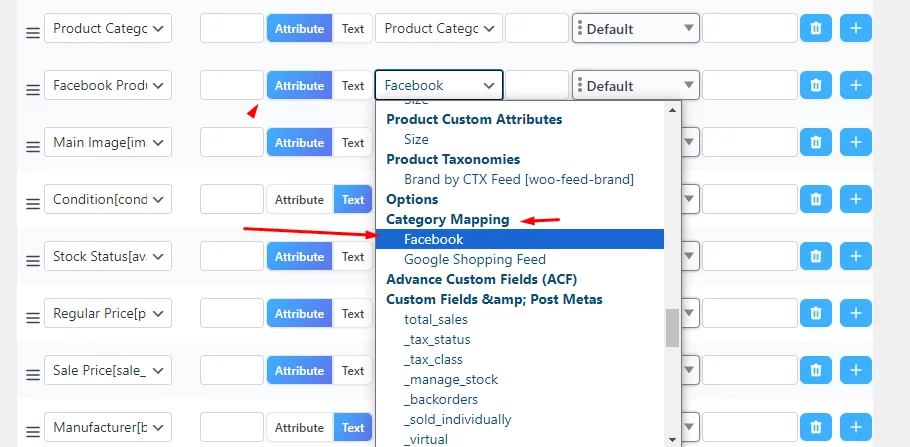
You can find the feed list & settings and update features on the Manage Feeds page.
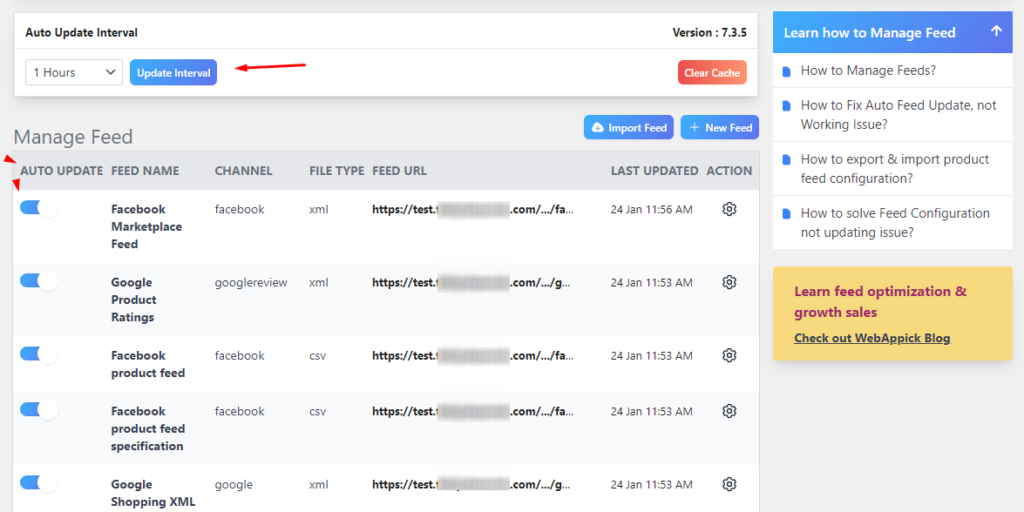
WooCommerce Facebook integration – Connecting feed to Facebook
Meta Commerce Manager is the platform that manages feed connections and product distributions to the Facebook Shop and Marketplace. It also distributes products to Instagram Shopping tools as well.
Note: You can use one single product feed to distribute and display products on both Facebook and Instagram eCommerce platforms.
If you are new to Commerce Manager, you will have to create a catalog first.
Creating a Catalog on Meta Commerce Manager
Log in to Commerce Manager with your regular Facebook username and password. Beginners will see the following screen.
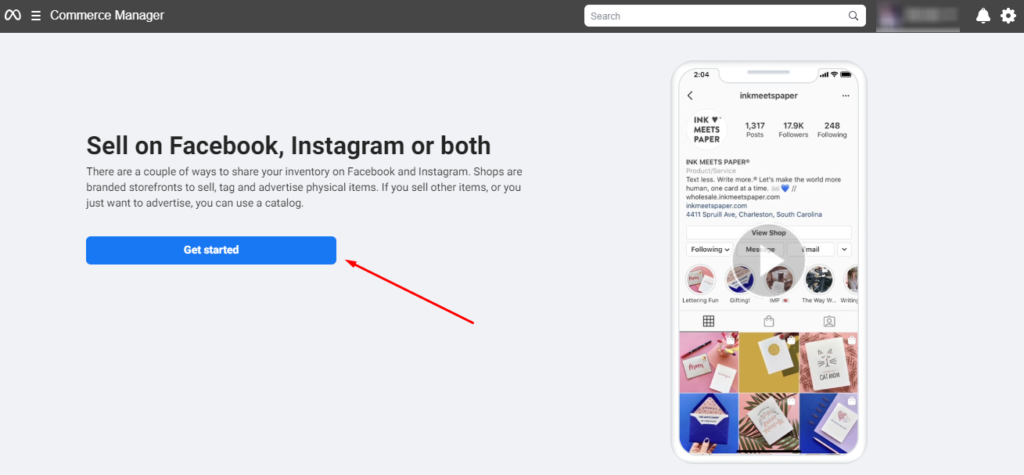
Click the button to proceed to the next window. If you are searching for how to integrate WooCommerce with Facebook Shop, then the first option is your answer.
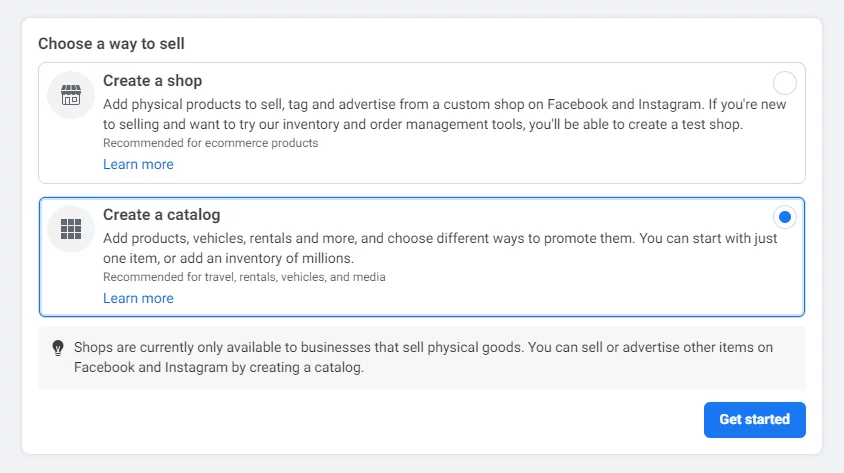
We will go with the catalog option. The catalog can distribute products on all possible eCommerce platforms on Facebook and Instagram.
Select eCommerce and then online products.
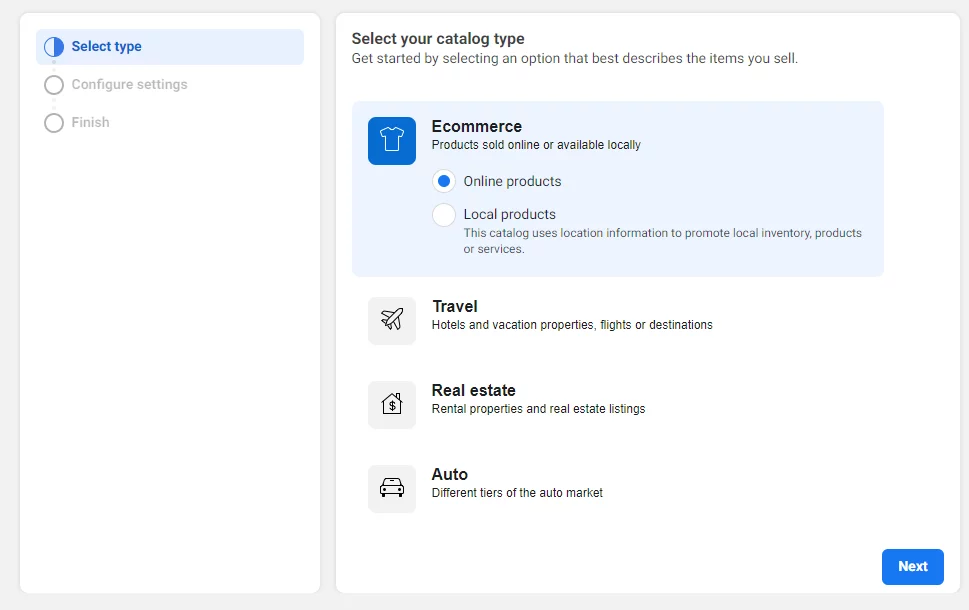
Select the following option, as we have a product feed we want to upload.
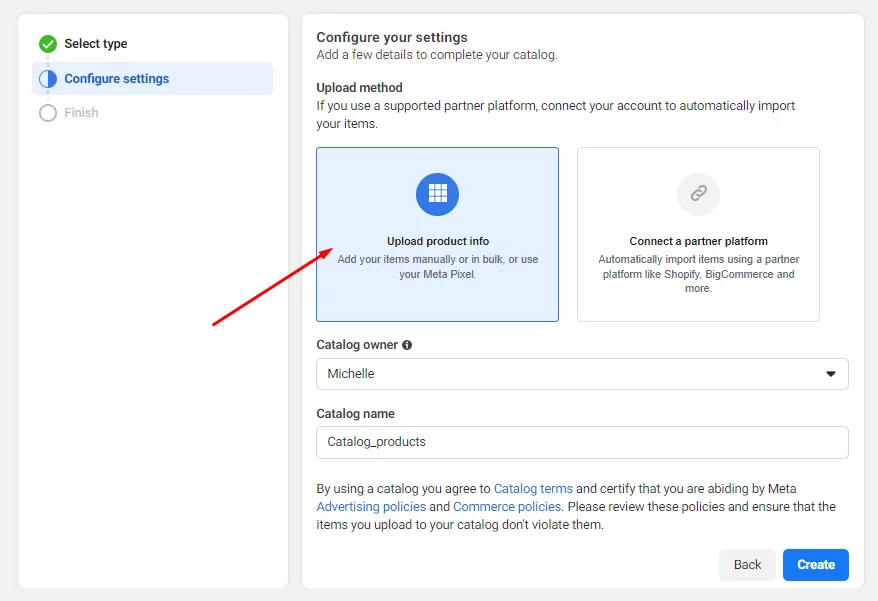
This will create an empty catalog.
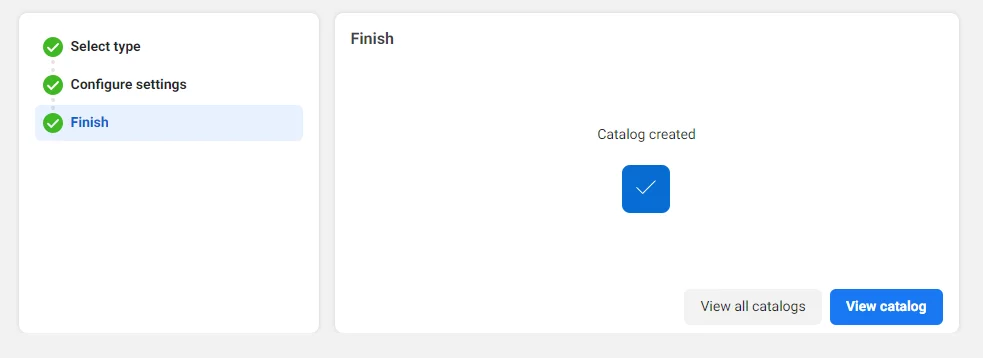
WooCommerce Facebook integration – Uploading/connecting Facebook product feed
Here’s what an empty catalog will look like.
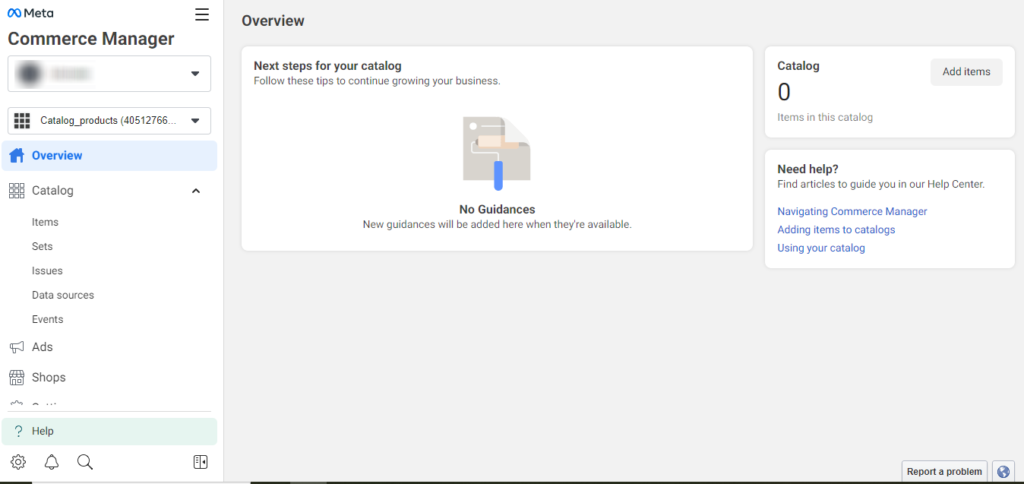
Click on Data Sources from the left panel. You can also download a Facebook data feed template to create a feed manually.
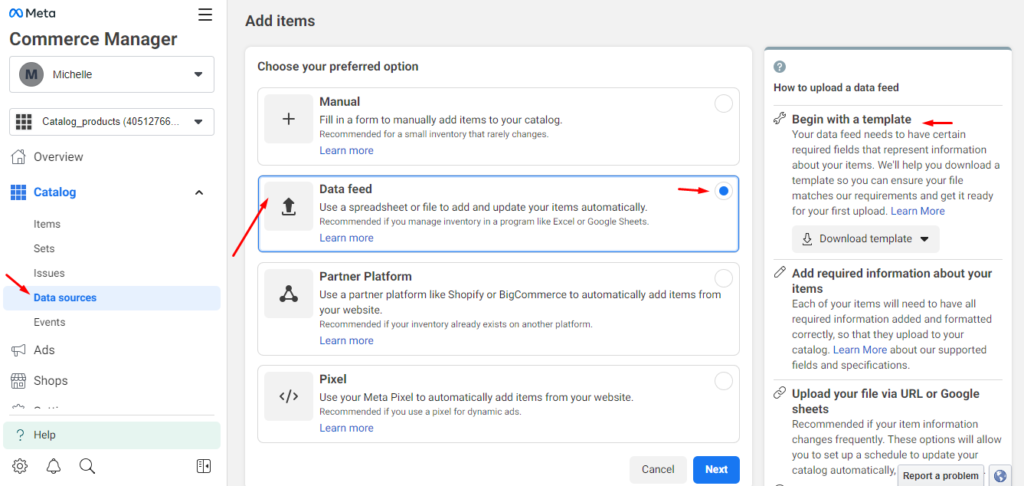
Anyway, click next after you select the Data Feed option.
Facebook will give you two options.
- Connect through a URL (We recommend this option)
- Upload from your computer
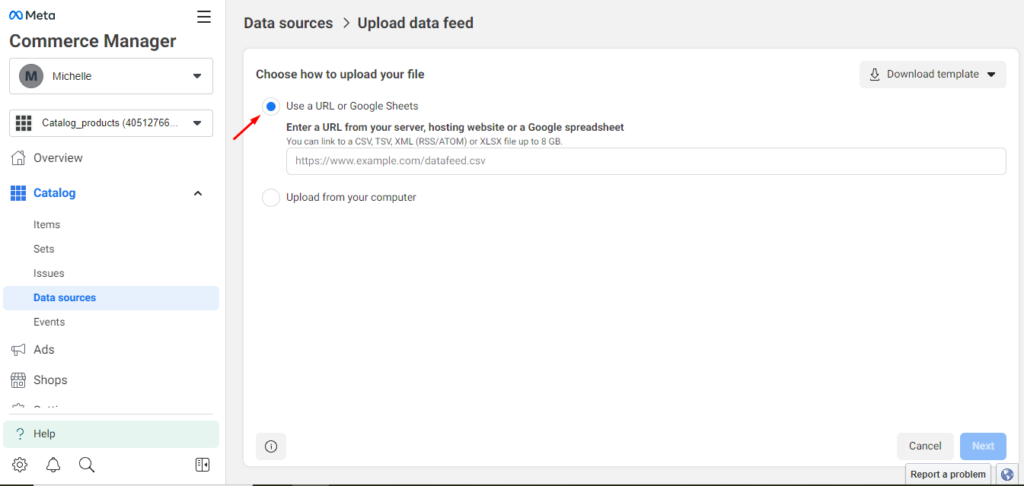
As previously stated, connecting through a URL brings numerous benefits and makes your feed management process completely effortless.
Go back to CTX Feed >> Manage Feeds and copy the feed URL.
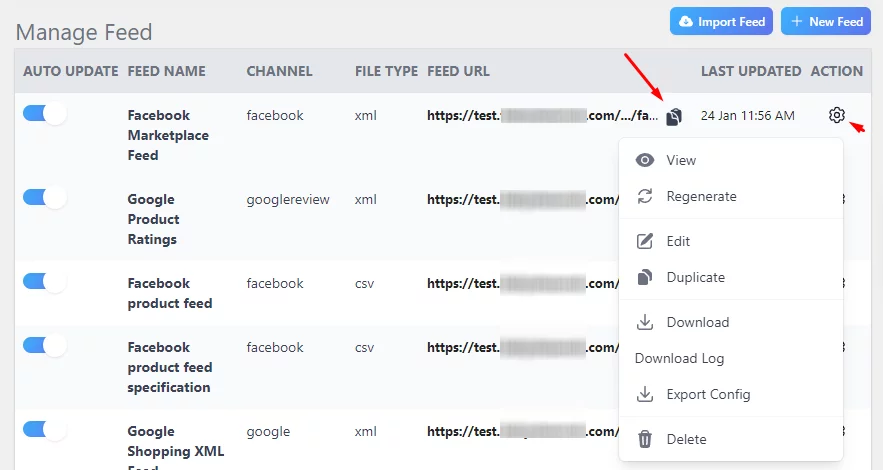
Paste it in the URL box and click next.
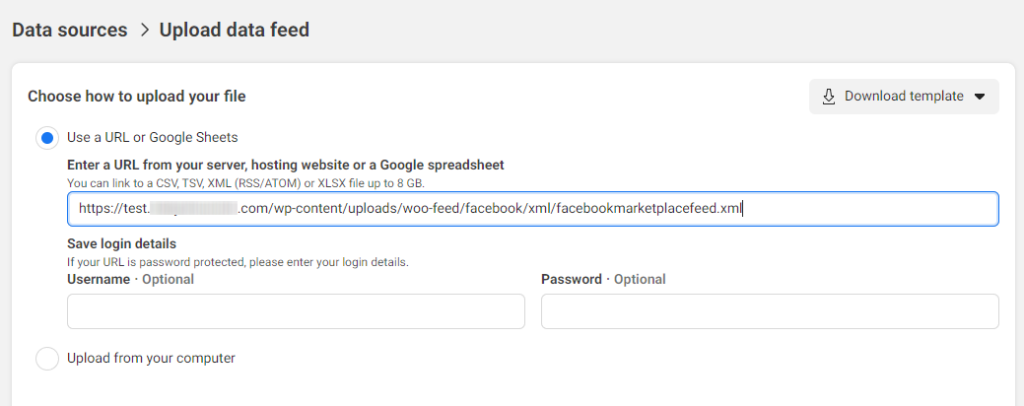
Now, Commerce Manager will let you input a feed name, set default currency, and, most importantly, set fetch frequency.
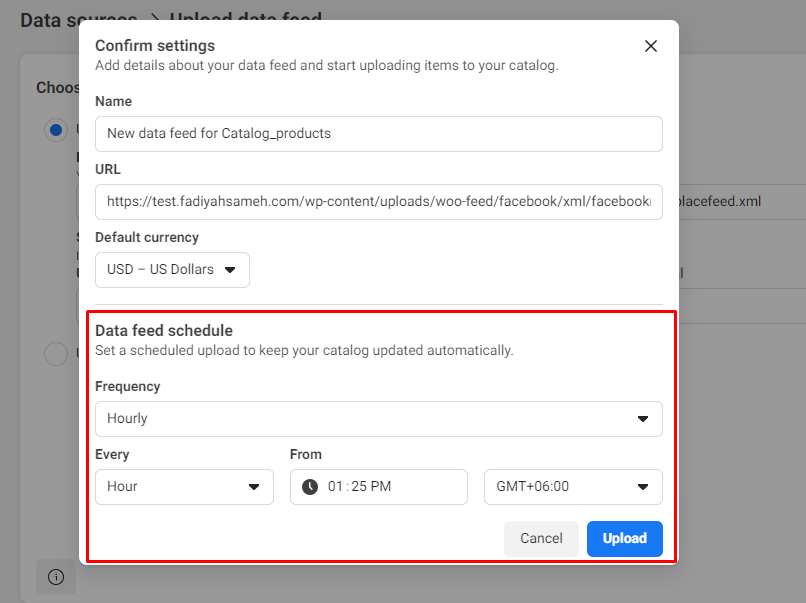
The fetch frequency is similar to CTX Feed’s update interval. Let’s say you have set an hourly update interval on CTX Feed and an hour fetch frequency on Commerce Catalog Manager.
Here’s how it works.
- If you add or make any changes to any of the products, CTX Feed will collect those updates after one hour, which is your set update interval.
- Meta Commerce Manager will look into your feed through the connected feed URL every hour as per your set fetch frequency.
- Commerce Catalog will fetch all your updates from the CTX Feed – feed link and update its listings.
Thus, Meta Commerce Manager and CTX Feed will work together to always display accurate and updated product details across all its platforms (Facebook and Instagram).
After you hit the upload button, the Catalog Manager will upload your items from the feed URL.
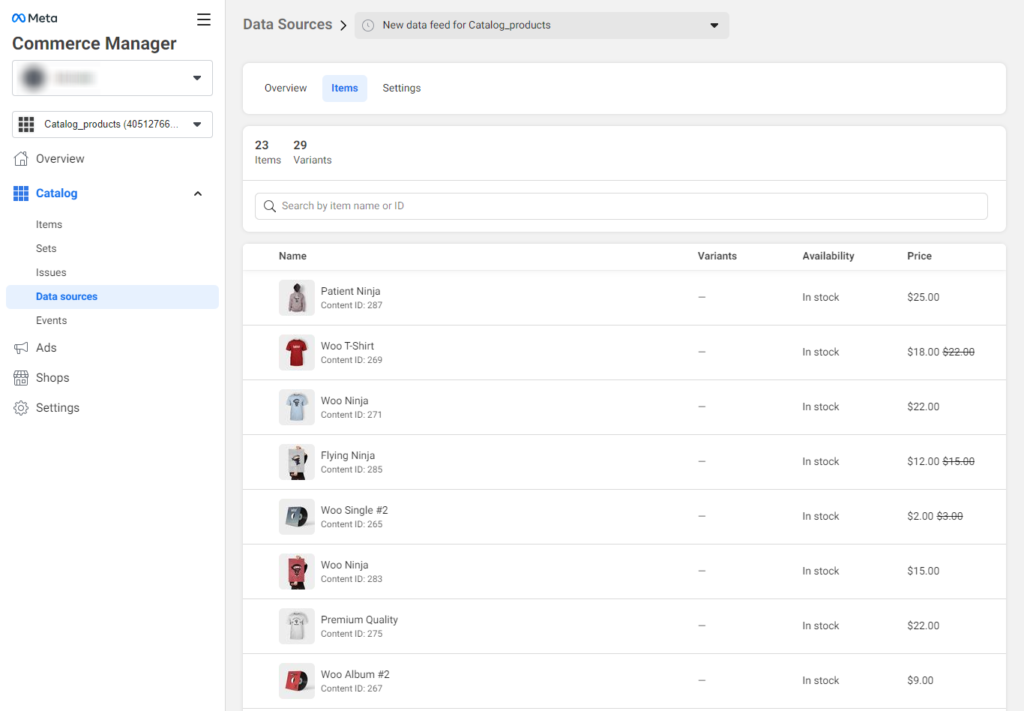
Remember, you must verify your business with Facebook before publishing your products on the Marketplace and Shop page.
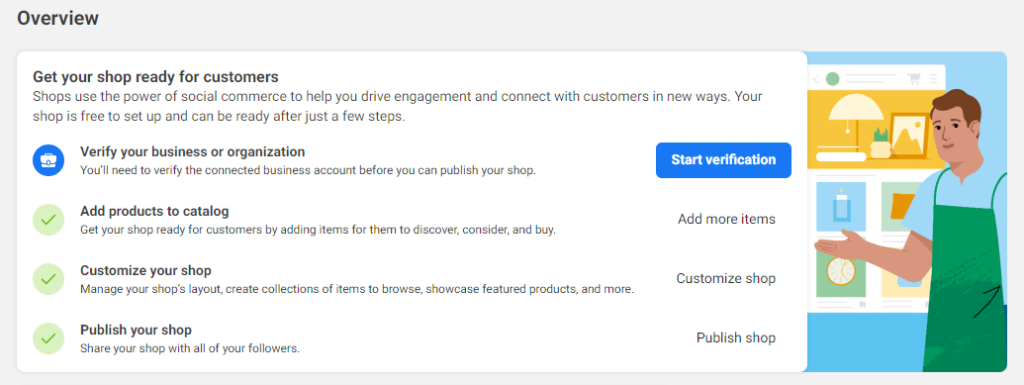
Advantages of WooCommerce Facebook integration
WooCommerce Facebook integration unlocks a treasure trove of advantages, propelling your brand and sales to new stratospheres. Let’s dive into the reasons why:
Increased visibility and reach
Facebook Marketplace offers your WooCommerce store an extensive audience, providing exposure to potential customers who might not have discovered your products otherwise. With millions of active users, your products can reach a diverse and vast customer base.
Cost-effective marketing
Utilizing Facebook Marketplace is a budget-friendly way to market your WooCommerce store. Unlike traditional advertising channels, it allows you to showcase your products without requiring a substantial financial investment, making it an attractive option for businesses of all sizes.
Seamless integration with WooCommerce
WooCommerce Facebook integration is seamless and user-friendly. This facilitates the synchronization of product listings, inventory, and order processing, streamlining the overall management of your online store.
Enhanced customer trust
By showcasing your products on Facebook Marketplace, potential buyers can view your store’s ratings and reviews, building trust in your brand. Positive feedback can significantly influence a customer’s decision-making process, increasing sales and fostering customer loyalty.
Local and global selling opportunities
Facebook Marketplace allows your WooCommerce store to tap into both local and global markets. Reach nearby customers looking for quick purchases while also engaging with a broader audience interested in your products from different parts of the world.
Personalized customer engagement
Leverage the social aspect of Facebook to engage with customers on a more personal level. Respond to inquiries, provide real-time assistance, and build a community around your brand, fostering a sense of connection with your audience.
Mobile-friendly platform
Given the prevalence of mobile usage, Facebook Marketplace provides a platform that is optimized for mobile users.
Your WooCommerce store can capture the attention of users browsing products on their smartphones. This, in turn, will increase the likelihood of conversions.
Quick and easy setup
Setting up your store on Facebook Marketplace is a straightforward process. The platform’s user-friendly interface ensures that even those with limited technical expertise can establish and manage their WooCommerce presence efficiently.
Social sharing and virality
Leverage the social sharing capabilities of Facebook to increase the visibility of your products. Customers can easily share their purchases, recommendations, or reviews, leading to organic growth and potential virality for your WooCommerce store.
Real-time analytics and insights
Gain valuable insights into customer behavior and preferences through Facebook Marketplace analytics. Use this data to make informed decisions, refine your marketing strategies, and optimize your WooCommerce store for better performance.
CTX Feed – Best WooCommerce Facebook integration plugin
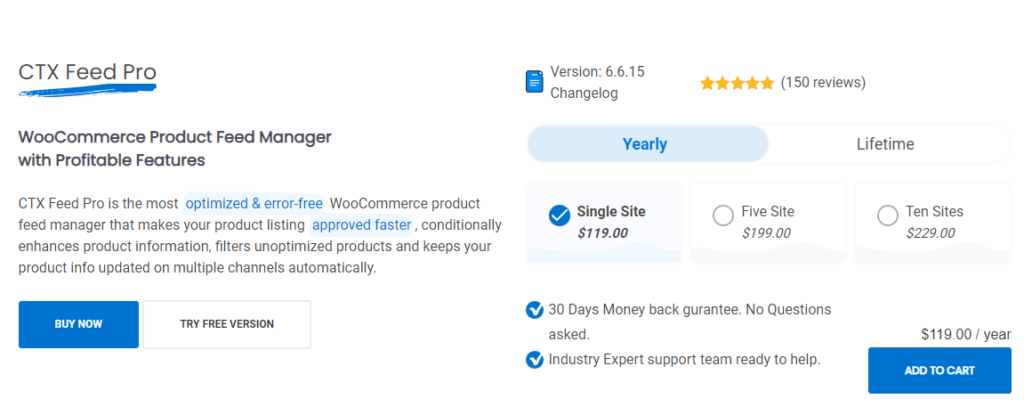
CTX Feed is designed to streamline the integration process with not just Facebook Marketplace but also other major channels like Google Shopping, Instagram, Pinterest, TikTok, Snapchat, eBay Ads, Bing Ads, and many more.
Streamlined feed creation
CTX Feed simplifies the creation of Google Shopping Product Feeds, Facebook Catalog Feeds, Instagram Catalog Feeds, and feeds for over 130 other channels. It eliminates the manual hassle of feed creation, making it more efficient.
Multichannel reach
Reach a broader audience by integrating your WooCommerce store with 130+ recognized channels. Extend your market presence beyond borders, targeting different marketplaces, search engines, affiliate sites, and price comparison platforms.
User-friendly interface
Enjoy an easy and intuitive user interface designed to make creating WooCommerce product feeds straightforward. All the essential elements for creating or customizing feeds are conveniently available on the same page, reducing the need for technical expertise.
Extensive template support
Choose from a selection of over 100 pre-configured templates tailored for major marketplaces. Save time and effort by leveraging these ready-made templates, ensuring your product attributes align seamlessly with each channel’s requirements.
Versatile feed file formats
CTX Feed supports five different feed file formats – XML, CSV, TSV, XLS, and TXT – offering unparalleled flexibility. Generate product feeds in formats preferred by different marketing channels, ensuring compatibility and optimal visibility.
Unlimited product and feed capabilities
Upload an unlimited number of products, regardless of your inventory size. Create an infinite number of feeds and easily manage them through the “Manage Feeds” option, providing unmatched flexibility.
Support for various WooCommerce product types
Seamlessly integrate with popular WooCommerce product types, including Bundle products, Composite products, mix-and-match products, and Subscription products. Ensure your product feed encompasses the diverse range of products offered in your WooCommerce store.
Dynamic attribute features
Set conditions on each attribute using the Dynamic Attribute feature, ensuring products meet specific criteria before inclusion in the feed. Customize product information dynamically based on selected attributes, enhancing compatibility with various marketing channels.
Advanced filtering and smart conditions
Utilize advanced filtering and smart conditions to include or exclude products based on specific criteria. Streamline your product feed by removing unwanted products and improving feed quality and relevance.
Category mapping for improved discoverability
Create and map categories for your products, enhancing their visibility in search results. Improve discoverability on search engines, especially crucial for Google Shopping feed, Facebook Catalog feed, and Pinterest Catalog feed.
Batch feed making for efficient processing
Overcome PHP execution time and memory limit constraints by creating feeds in batches. Ensure smooth processing, especially for stores with a large inventory, preventing errors and feed rejection.
Automatic feed updates
Set intervals for automatic feed updates, saving time and effort on manual updates. Choose from multiple intervals to keep your product information current without needing constant manual intervention.
Dynamic discount and pricing integration
Automatically integrate discounting and pricing information into your product feeds. Compatible with popular discount and pricing plugins, such as Discount Rules for WooCommerce and WooCommerce Dynamic Pricing & Discounts.
SEO title and meta description support
Compatibility with leading SEO plugins – Yoast SEO, All in One SEO, and Rank Math SEO. Assign SEO Meta Titles and Meta Descriptions to enhance your products’ visibility in search engine results.
Built-in plugin cache for server load reduction
Enjoy a built-in caching feature that reduces server load during feed generation. Generate product feeds efficiently without putting excessive strain on your server.
CTX Feed is not just a WooCommerce product feed plugin; it’s your key to effortless WooCommerce Facebook integration and integration with other major channels. Enhance your product visibility, streamline feed creation, and optimize your marketing efforts with this powerful and user-friendly plugin.
Wrap up
In conclusion, WooCommerce Facebook integration offers numerous advantages, ranging from broadening your audience reach to fostering customer trust and engagement. This symbiotic relationship allows you to enhance your online presence, drive sales, and establish a more personal connection with your customers.

I enjoyed it as much as you’ll get carried out right here. The sketch is attractive, your authored material stylish. Nonetheless, you command get an edginess over that you wish to be delivering the following. I’ll unquestionably come more formerly again, as exactly the same nearly very often inside case you shield this hike.